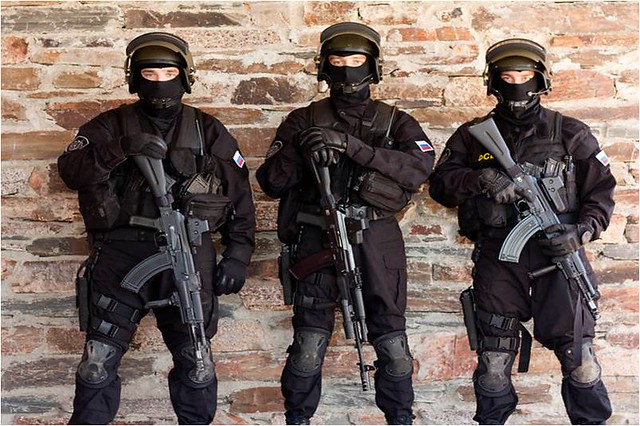RUSSIAN SPETSNAZ – Russian Special Forces During the 1970’s, when the Cold War was at its height, the West became aware of the existence of Soviet Spetsnaz troops, which were grouped into what were known as “diversionary brigades.” Although the Cold War is over, Spetsnaz units are still part of the Russian order-of-battle, although their missions have changed. The Spetsnaz (Troops of special purpose) were raised as the troops of the Main Intelligence Department – GRU and in the 1980s numbered 30,000 soldiers. These were deployed: one Spetsnaz company per Army; one Spetsnaz regiment in each of the three “theaters of operations”; one Spetsnaz brigade in each of the four Soviet Fleets; and an independent Spetsnaz brigade in most military districts of the USSR. There were also special Spetsnaz intelligence units, one to each Front and Fleet: total 20. A Spetsnaz company was 135 strong, normally operating in 15 independent teams, although they could also combine for specific missions. A Spetsnaz brigade was 1,000-1,300 strong and consisted of a headquarters, three or four parachute battalions, a communications company, and supporting troops.

It also included an anti-VIP company, composed of some 70-80 regular troops whose mission was to seek out, identify and kill enemy political and military leaders. A naval Spetsnaz brigade had a headquarters, two to three battalions of combat swimmers, a parachute battalion, supporting units, and an anti-VIP company. It also had a group of midget submarines designed to deliver combat swimmers to distant targets. The existence of Spetsnaz was a closely guarded secret within the Warsaw Pact and individual troops were not allowed to admit membership, to the extent that army Spetsnaz wore standard airborne uniforms and insignia, while naval Spetsnaz wore naval infantry uniforms and insignia. RUSSIAN SPETSNAZ GRU GSO (GROUP OF SPECIAL OPERATION).
Russian Spetsnaz GRU The Spetsnaz GRU was designed to carry out reconnaissance and sabotage activity on the enemy’s territory. Masterclips 150,000 Premium Image Collection 14 Pack. The spetsnaz’ main missions was to destroy the command posts for the guidance of nuclear weapons and other, the most important, the enemy installations. Acting in groups of five to ten people, the GRU spetsnaz is able to act autonomously for several days. It was a troop of soldiers who went through special physical and psychological training, in which special emphasis is placed on mastering the weapons, skill in radio communications, and knowledge of the enemy’s territory.
Grass Unisoft Vs Blumotion more. Travel Services. Course Title. Training Courses. Ask Us; FBS Resources. Email Maintenance; All Courses Alpha. Accounts Payable; Best Practices for Cash Control.
The GRU’s special operations troops differ from airborne troops in the character of their mission. Airborne troops are, in essence, a special kind of infantry, which undertake military operations. The mission of the GRU’s spetsnaz was to carry out its orders secretly, without engaging in military operations – to search, to find, and to destroy. After Budennovsk, some people said that the only ones who could have coped with the situation would have been the GRU’s spetsnaz. In fact, the GRU’s special operations troops are trained to gather information and destroy it.
They were not trained to save hostages. The GRU’s spetsnaz, originally, was designed to destroy the enemy’s command posts, the systems for guiding the enemy’s armed forces and their weapons, and the physical elimination of the opposite side’s military and political leadership. Russian Spetsnaz GRU VMF There was a broad spectrum of such forces in Russia, ranging from the army, where “dolphins and beluga whales”, especially trained by specialists of the Defense Ministry’s Scientific Research Center No. 172, serve as underwater saboteurs, to social structures worthy of the attentions of the Russian special services.